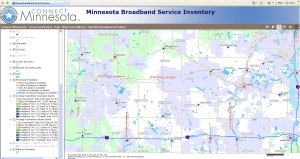Two broadband ISPs serve my home in a small town in Southwest Minnesota, Frontier Communications and Mediacom, apparently at Broadband Tier 2 with potential residential download speeds of 1.5 to 3 Mbps and uploads (1st Generation Data) at 200 kbps to 768 kbps . So says a new project here in Minnesota.
Connect Minnesota, a non-profit subsidiary of Connected Nation, is releasing results of their broadband mapping project. As I gushed in January, I learned about the project from Blandin on Broadband, who explains that “The maps are being created to help the Ultra High-Speed Broadband Task Force make recommendations to the Legislature regarding a vision for broadband access in Minnesota.”
The idea was Connected Nation (CN) contacted ISPs (internet service providers) who provided them with broadband service maps, which this firm then tested from their office in Texas. They also asked people to test their own connections, which info was supposed to keep the ISPs honest. I clocked our cablemodem-linked network at the office at 7286 kbps d/l 512k u/l.
Connect Minnesota has posted PDF & gif maps showing infrastructure, availability and speed on the ground, as well as an interactive map here. The screenshot above is from the interactive map (which is a bit clunky & times out relatively quickly IMHO). They have an address finder so you can easily pinpoint your home location and inventoried service providers, although it is unclear which providers provide which speeds.
It’s nice in theory but I wonder how much the ISP info really got tested. CN did move their testing from Texas to Chicago after some criticism tho the biggest holes in the donut are Outstate Minnesota. Come out on the Buffalo Ridge and try your gee-whiz gizmos. A quick lookup for a co-worker who lives out in the country looks like they mapped the Frontier service area, not necessarily where DSL actually works. It would be nice to have different types of service providers—Cable, DSL, wireless—as separate layers but I expect they were trying to keep it simple. The interface should be relatively easy for non-GIS types to navigate and provides some good information for consumers and policymakers.
Minnesota’s Broadband Taskforce is meeting today to look over the report for themselves, which I expect Blandin on Broadband will fill us in on ASAP. Myself, I’ll have to try the site at home and see if it loads at all for anybody still on dial-up 🙂 .


 STrib
STrib The Economist
The Economist
JC I encourage you to contact Connect Minnesota about your experience and get the neighbors to do it too! (They have a contact form on their site: http://www.connectmn.org/_forms/Connection.php) I got the feeling from the map presentations this week that the Connected Nation people are open to getting feedback and that they will follow up on it. I don’t know if it’s true – but there’s only one way to find out.
I say let’s make ‘em work for their money and give us what we need – a well tested and verified map.
Thanks! Ann
My co-worker was bummed when she called Frontier. First they said, Sure! She asked the operator to double check. Then they said, Sorry….
I imagine this is a huge undertaking and don’t mean to disparage their product, just have some healthy skepticism. It’s an interesting project.
I’m with you – I think we’re right to be a little skeptical.
My hope is that we can use the skepticism to get the best out of the project. If we don’t call them out then all they have to go on is the providers’ word – sometimes that helpful, sometimes not.
The story about your neighbor is sadly typical I think. A lot of providers will say they have an area covered but once you dig a little, you can find the holes. We need a map that has uncovered those holes too.